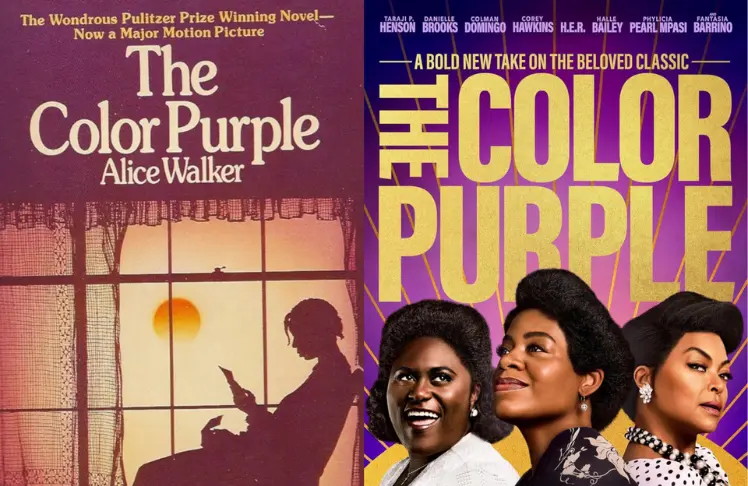
Growing up, “The Color Purple” was more than just a movie playing on the television in my family’s living room — it was a window into the future challenges of racism and sexism I’d face as a Black woman.
Watching the 1985 classic for the first time, I was too young to fully grasp the depth of its message. But now, along with my personal experiences, I report on depression, domestic violence, and maternal mortality — issues that impact Black women. So when Sophia, portrayed by Oprah Winfrey, famously declares, “All my life I had to fight,” I understand all too well the relentless battle against systemic injustices that the film — and the book — represents.
“The Color Purple” sums up what it means to be a Black woman in America: To constantly have your guard up against systemic racism, gender violence, and internalized hate. To win some. To lose some. And if you’re fortunate, you live to fight another day.
“‘The Color Purple’ is sacred text. It is work that really means so much to so many people, been a source of healing for many,” Ghanaian American filmmaker Blitz Bazawule who directed the modern rendition of Alice Walker’s beloved 1982 novel, told NPR’s Morning Edition.
On New Year’s Day, I watched the 2023 musical reimagining of the story at a local theater with a friend, also a Black woman. By the time the credits were rolling with the names of actors Fantasia Barrino, Taraji P. Henson, and Danielle Brooks displayed on the big screen, I’d cried too many times to count.
In the pain experienced by the characters, I felt validated. And as they reclaimed their destinies and personhood the best they could, I felt hopeful.
“It’s a story of claiming your voice among oppressive systems created to maintain power and control over you,” Aaliyah Nurideen, a New Jersey-based licensed clinical social worker, says about why the story resonates with Black women.
“‘The Color Purple’ represents giving permission and hope for Black women’s resilience and rebellion; challenging the ways in which oppression, generational trauma, patriarchy, and racism are sustained to the detriment to our collective well-being,” Nurideen says.
The Healing Power of Film
Cinema has the power to help viewers heal mental and emotional wounds. There’s an entire subgroup of therapy called cinematherapy dedicated to using movies and animation as healing tools. Research shows that it can decrease hopelessness and support self-discovery.
During one-on-one treatment with a therapist, patients are prescribed specific films to watch to process their challenges. Jonathan Decker, a licensed therapist based in Utah, offers people around the world a peek into the therapy form through his YouTube channel “Cinema Therapy.”
“This is what trauma is for a lot of people. You feel like your world is safe. Something terrible happens, and now the world is unsafe,” Decker said during an analysis of “Finding Nemo.”
“That made you feel scared. That made you feel panicked. We don’t like to feel those things,” Decker continued. “And so, what do we do? We try and control our environments and we try to control other people so that we can control the outcome so that we can feel safe.”
Aside from swimming, no human can relate to the trauma of being hunted or lost in the great, big ocean as a tiny fish. But we can relate to the fear of being murdered by police or being without phone service in a historically racist town. And Black women can relate to what we see our sisters in “The Color Purple” experience.
Racism and Sexism in ‘The Color Purple’
While watching the 2023 version of “The Color Purple,” my heart dropped seeing Celie’s newborn daughter, Olivia, ripped from her arms at birth. I resonated with her pain on another level when, as she aged, still separated from her children, she questioned God about the reproductive injustice.
“If God love me, then why He take my babies?” Celie, portrayed by Fantasia Barrino, asked Shug Avery, portrayed by Taraji P. Henson, in a field of purple flowers.
“Sounds like man did that. Not God,” Shug responded.
Celie’s journey of finding her stolen children is a reminder of what so many Black women in the U.S. don’t experience. Every year, 10 Black infants die per 1,000 live births, often in response to neglect by the medical system. And there’s no guarantee a Black mother will see her child survive an interaction with the officers. In 2023, 32 unarmed Black people were fatally shot by police.
Celie’s cry was a collective cry — and I jumped for joy when she received the miracle of her adult children returning to her in one piece.
And as Marissa Evans pointed out in the Los Angeles Times in December, “In order to appreciate Celie’s path to freedom, you have to bear witness and sit with the uncomfortable and complex truths about the harm she endured whether reading it or watching it.”
Evans notes however, that “The other reality is resilience is not always enough for Black women to overcome the challenges of social, systemic and institutional misogynoir.”
I mourned for Sophia, portrayed by Danielle Brooks, as she was tortured for six years in jail after refusing to be a housemaid for the mayor’s wife, a white woman. It’s a portrayal that has earned Brooks an Academy Award for Best Supporting Actress nomination, a Screen Actors Guild Awards Outstanding Supporting Actress nomination, and an Outstanding Supporting Actress in a Motion Picture nomination from the NAACP Image Awards.
Sophia’s story represented the ongoing issue of mass incarceration among Black women, who represent 44% of women in jail, despite accounting for only 13% of U.S. women. I celebrated the first time she laughed after her release, a sign she’d regained her voice.
Watching “The Color Purple” as a girl filled me with curiosity. Watching it as a woman sparked feelings of grief, resilience, and liberation. It’s more than just a story — “The Color Purple” is a reminder of the collective strength and beauty of Black women.















